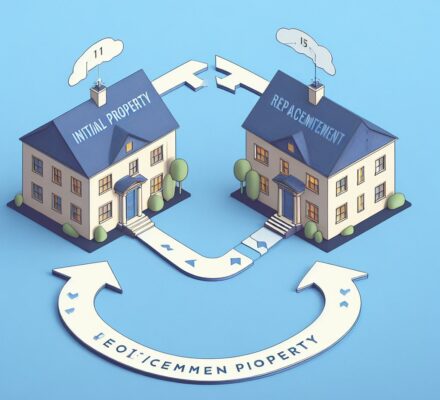Imagine stepping into the complex world of 1031 exchanges, where gains are left unrecognized.
Delve into the rules that govern this intricate process, from the requirements for like-kind property exchanges to the timeframes for identifying and acquiring replacement properties.
Discover the restrictions on personal use of replacement property and the essential reporting and documentation requirements.
This article will serve as your detailed guide to navigating the intricacies of non-recognition of gain in a 1031 exchange.
Key Takeaways
- Both the relinquished property and the replacement property must be held for productive use in a trade or business or for investment purposes.
- Personal residences or properties held for personal use don’t qualify for like-kind exchanges.
- The properties involved in the exchange must be of like-kind.
- The exchange must be facilitated by a qualified intermediary.
Requirements for Like-Kind Property Exchanges
To qualify for non-recognition of gain in a 1031 exchange, you must meet certain requirements for like-kind property exchanges. These requirements ensure that the properties being exchanged are indeed of like-kind and that the exchange is done in a proper and legitimate manner.
Firstly, both the relinquished property (the property being sold) and the replacement property (the property being acquired) must be held for productive use in a trade or business or for investment purposes. Personal residences or properties held for personal use don’t qualify for like-kind exchanges.
Secondly, the properties involved in the exchange must be of like-kind. This means that the nature or character of the properties must be similar, even if they differ in grade or quality. For example, an apartment building can be exchanged for a commercial office building, as they’re both real estate properties.
Thirdly, the exchange must be done within a specific time frame. The replacement property must be identified within 45 days of transferring the relinquished property, and the exchange must be completed within 180 days. These time constraints are crucial to qualify for non-recognition of gain.
Lastly, it’s important to note that the exchange must be facilitated by a qualified intermediary. This party acts as a facilitator to ensure that the exchange is done correctly and helps to maintain the tax-deferred status of the transaction.
Understanding and meeting these requirements is essential for a successful like-kind property exchange under Section 1031 of the Internal Revenue Code.
Timeframes for Identification of Replacement Properties
Once you have identified the relinquished property, you must promptly move on to the next step in the 1031 exchange process: identifying the replacement properties within the given timeframe. This is a crucial aspect of the exchange, as failing to meet the time requirements can result in the disqualification of the entire transaction.
Here are the key points you need to know about the timeframes for identification of replacement properties:
- 45-Day Identification Period: You have 45 calendar days from the date of closing on the relinquished property to identify potential replacement properties. This timeframe is non-negotiable and can’t be extended.
- Three-Property Rule: You can identify up to three potential replacement properties without any regard to their fair market value.
- 200% Rule: If you wish to identify more than three properties, you must adhere to the 200% rule. This means that the total fair market value of the identified replacement properties can’t exceed 200% of the relinquished property’s fair market value.
- Specificity of Identification: The identification must be in writing and signed by you. It should include a clear description of each property, such as the address or legal description.
Ensuring that you meet the identification timeframe is crucial for a successful 1031 exchange. Now, let’s delve into the timeframes for the acquisition of replacement properties.
Timeframes for Acquisition of Replacement Properties
Now, you need to focus on acquiring the replacement properties within the designated timeframe. The Internal Revenue Code sets specific timeframes that you must adhere to in order to successfully complete a 1031 exchange. These timeframes are crucial as they determine whether the exchange will qualify for non-recognition of gain.
The following table outlines the timeframes for acquiring replacement properties in a 1031 exchange:
| Timeframe | Requirement |
|---|---|
| Identification Period | Within 45 days of the transfer of the relinquished property, you must identify potential replacement properties. You can identify up to three properties or any number of properties as long as their fair market value does not exceed 200% of the relinquished property’s value. |
| Exchange Period | You must acquire the replacement property or properties within 180 days of the transfer of the relinquished property. This period includes the 45-day identification period. If the deadline falls on a weekend or holiday, it is extended to the next business day. |
| Extension | In some cases, you may be eligible for an extension of the 45-day identification period or the 180-day exchange period. You must file a written request with the IRS to obtain an extension, and it must be done before the initial deadline. |
It is important to note that failure to meet these timeframes can result in the disqualification of the exchange and the recognition of gain. Therefore, it is crucial to work closely with a qualified intermediary and adhere to the specified timeframes to ensure a successful 1031 exchange.
Restrictions on Personal Use of Replacement Property
During the 1031 exchange process, you must adhere to restrictions on personal use of the replacement property. These restrictions are in place to ensure that the exchange qualifies for non-recognition of gain under Section 1031 of the Internal Revenue Code.
Here are four important things to know about the restrictions on personal use of replacement property:
- Holding period requirements: To qualify for non-recognition of gain, you must hold the replacement property for investment or productive use in a trade or business. The IRS generally requires you to hold the property for at least two years after the exchange.
- Intent to hold for investment: You must have a genuine intent to hold the replacement property for investment purposes. This means that you can’t use it as a personal residence or for personal purposes during the holding period.
- Limited personal use: While you can’t use the replacement property for personal purposes during the holding period, there are some exceptions. The IRS allows for incidental personal use, such as staying at the property for a limited number of days per year, as long as the primary use remains for investment or business purposes.
- Documentation and record-keeping: It’s crucial to maintain proper documentation and records to demonstrate your intent to hold the replacement property for investment purposes. This includes keeping track of any personal use and ensuring it doesn’t exceed the allowed limits.
Reporting and Documentation Requirements
To meet the reporting and documentation requirements for a 1031 exchange, you must ensure proper record-keeping and provide necessary documentation. This is crucial to demonstrate that your exchange qualifies for non-recognition of gain under Internal Revenue Code Section 1031.
Firstly, it’s important to maintain accurate records of the relinquished property and the replacement property. This includes detailed descriptions, purchase agreements, closing statements, and any other relevant documents. These records will help establish the value of the properties involved in the exchange.
Additionally, you must report the exchange on your tax return using Form 8824, Like-Kind Exchanges. This form requires you to provide information about the properties exchanged, the dates of the exchange, and the gain or loss realized. It’s essential to accurately complete this form to ensure compliance with the reporting requirements.
Moreover, you should retain all documentation related to the exchange for at least three years from the due date of the tax return for the year in which the exchange occurred. This includes records of the exchange agreement, correspondence with the qualified intermediary, and any other supporting documents. Retaining these records will be valuable in case of an IRS audit or if any questions arise regarding the exchange.
Frequently Asked Questions
What Are the Tax Implications of a 1031 Exchange?
When considering a 1031 exchange, it’s crucial to understand the tax implications. By deferring capital gains tax, you can reinvest your profits into another property. Seek professional advice to navigate the rules effectively.
Can a Vacation Home Be Used as Replacement Property in a 1031 Exchange?
Yes, a vacation home can be used as replacement property in a 1031 exchange. However, there are specific rules and requirements that must be followed to ensure non-recognition of gain.
Are There Any Restrictions on the Type of Property That Can Be Exchanged in a 1031 Exchange?
There are restrictions on the type of property that can be exchanged in a 1031 exchange. The property must be held for investment or business purposes, and certain types of property, like stocks or bonds, are not eligible.
What Happens if the Replacement Property Is Not Identified Within the Specified Timeframe?
If you don’t identify a replacement property within the specified timeframe, you won’t qualify for non-recognition of gain in a 1031 exchange. This means you’ll have to pay taxes on the gain.
What Documentation Is Required to Report a 1031 Exchange to the Irs?
To report a 1031 exchange to the IRS, you need to provide documentation like the Form 8824 and the settlement statement. These documents are crucial in demonstrating the non-recognition of gain in the exchange.




